The internet is widely regarded as one of, if not the most important inventions of the modern day. It’s also given rise to some of the most powerful corporations that exist today and has sent plenty of businesses, and business models, into the realm of the insolvent and the obsolete.
With the internet has come the 'paywall'. The paywall has become one of the key ways online as well as digitally forward traditional businesses reap revenue from their customers. It’s also become something of a 'dirty' word among consumers accustomed to the internet’s deluge of free information and entertainment.
But what is a paywall, are there different types of paywalls, and how can you as an entrepreneur deploy a paywall without inconveniencing or losing customers? We’ll get into all of that in this guide, so read on!
What is a Paywall?
A paywall is a way of monetizing online content by restricting access to some or all of it until the consumer pays a fee or completes a subscription. It’s a strategy that tends to meet with the ire of many consumers, given that the internet offers a large variety of entirely free content. However, many businesses have embraced the paywall in various forms, especially within the publishing industry.
The paywall can be viewed as an evolution of how print media such as newspapers and magazines were consumed prior to the internet—generally, every household would either subscribe to a newspaper and/or certain magazines, which would then be delivered to their door, or purchase said print media at a newsagent or newspaper stand.



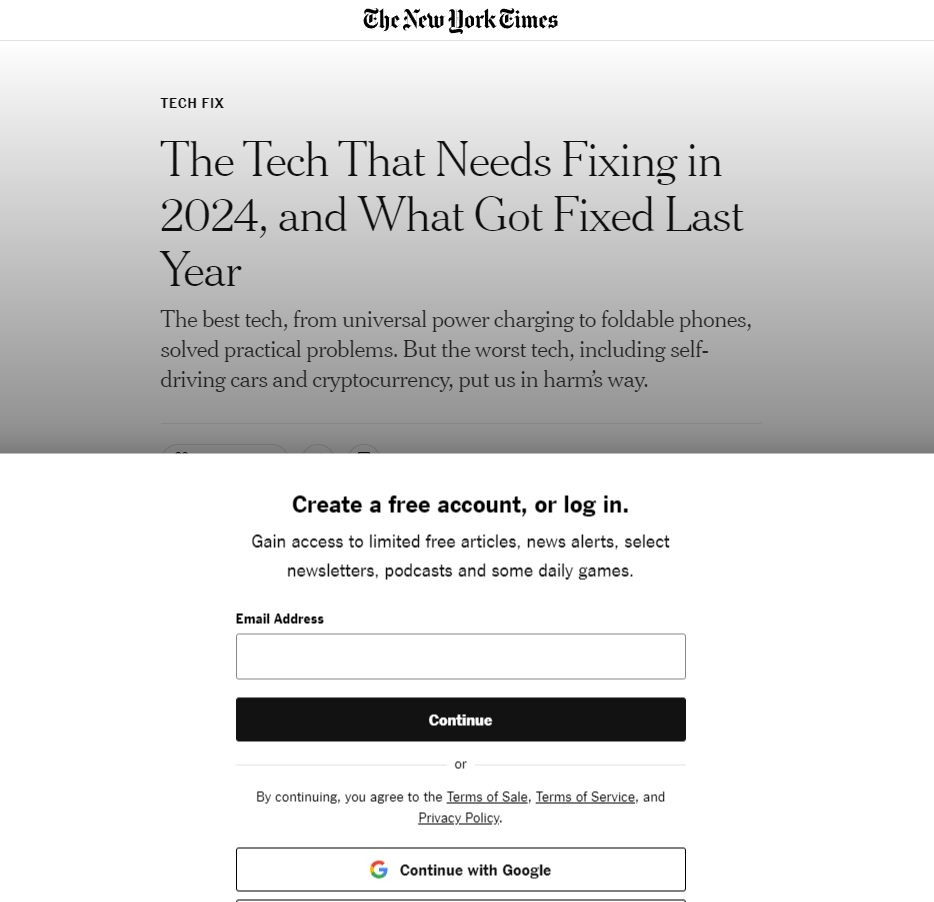
These subscriptions and purchases contributed significantly to the revenues of the respective news firms and publishing houses. With the advent of the internet and the rise of free media, however, these revenues came under threat. While advertising revenue contributes even more heavily to the business’ coffers, this loss of subscription revenue is one that many refuse to swallow—hence the rise of the paywall.
That said, paywalls come in different types and can be used effectively by all sorts of content-based businesses. Despite the fact that consumers tend to dislike them, many firms that use them tend to report increases in subscription numbers after implementing paywalls.
Types of Paywalls
In order to dig deeper into the concept of paywalls and examine whether it’s a good option for your business, we need to take a look at the different types of paywall models. They are:
Hard Paywalls
These are the paywalls that most people think of, where clicking on a link to a news story or article sees the visitor immediately blocked from reading or viewing any content and being confronted with subscription terms. The main risk with hard paywalls is that the visitor simply closes the page, leaves the site, and attempts to search for the same or similar content elsewhere.
Using a hard paywall can therefore severely limit the number of visitors your site has since it’s unlikely that anyone would want to pay before at least sampling your content for quality. For this reason, you’ll generally only find hard paywalls being used by sites with either a unique product or particularly authoritative branding.
A hard paywall can also have a negative effect on advertising revenue, since advertisers are aware that many site visitors won’t be given a chance to see their ads at all. As such, a hard paywall has significant disadvantages not just for the consumer but also for the business using them.
Soft Paywalls
Soft paywalls are extremely unobtrusive, and you can compare them to a “freemium” content model. Generally, there’s a mix of content on offer here—much of it for free, but customers who decide that they like the content and want even more can purchase a subscription to receive extra or exclusive content.
You’ll find soft paywalls in use across a variety of platforms and services, from news sites to blogging platforms and even music and dating apps. Individual content creators also tend to use this model, building up a fan base via free content and operating an exclusive subscriber community whose members pay for more.
Metered Paywalls
Metered paywalls are somewhere in between soft and hard paywalls, because they set a limit on how much content a visitor can access for free before being required to pay. This is an extremely common model in news as well as education, but SaaS firms are also known for using this model in various ways.
This model can be considered quite similar to the soft paywall, but there tends to be one major difference between the two. In a soft paywall, there tends to be a certain section or type of content that’s behind the paywall—or in the case of SaaS subscriptions, a set of advanced features that can’t be used until you subscribe. In the metered paywall model, you can generally access everything, but only a limited number of times.
Dynamic
Websites are extensively configurable, and analytics allow site operators to collect data on visitors and evaluate the way they use the site. In this manner, a publisher or content creator can develop certain insights and models of their customers, anticipating their behavior based on what they have seen.
The end result here is that the paywall can be configured to work differently based on the site visitor’s profile and data. Visitors who frequent the site often or take in a lot of content may be prompted to subscribe fast, whereas occasional visitors may not be prompted at all.
Donations
As content creation becomes even more prevalent and platform after platform begins charging consumers via paywalls, some creators and websites give their subscribers the choice to donate rather than forcing them to pay. This tends to be entirely voluntary, asking consumers of the site’s content to support them if and when able.
This sort of voluntary or open paywall tends to be prevalent across various content creation platforms where visitors can tip creators, but some major businesses including a leading UK newspaper have used this model successfully.
Which Sites Use Paywalls?
As already mentioned in the previous section, various types of businesses use different types of paywalls. It’s common to see soft paywalls being used by various apps, metered paywalls used by SaaS companies, and hard paywalls in play when you visit a big-name U.S. news site.
There’s nothing wrong with using a paywall, and whether you’re a content creator or a SaaS entrepreneur, you may find that different types of paywalls can work for you. There are plenty of examples of firms that have found plenty of success using them, after all.

The Wall Street Journal, for example, is famous for its hard paywalls. One may argue that the small teaser text and access to the home page would qualify for being a soft paywall, but that isn’t so. The site certainly has the branding and name recognition to use a hard paywall successfully, and whatever you may think of the tactic, WSJ has plenty of subscribers willing to pay for their content.

The New York Times charges the same amount overall though at a different frequency, and uses a form of paywall that could be described as metered since it offers access to a limited amount of content with a free account. That said, you may not consider a free account truly free, since you’re paying with your data.
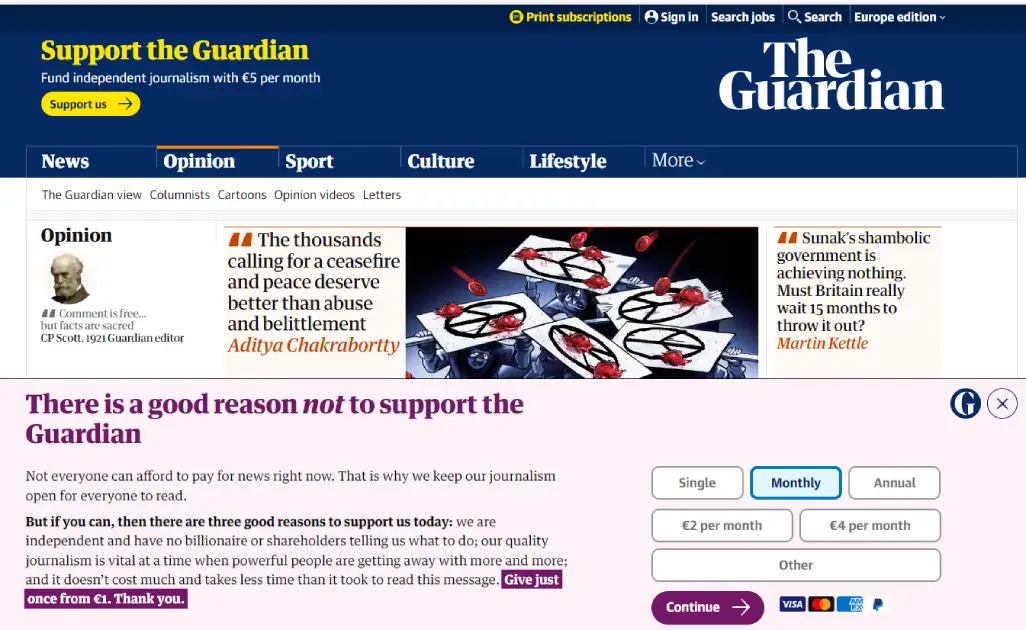
The Guardian, meanwhile, is a fine example of the donation model. You can use the site and read all of the news for free, but you’ll see several appeals for a donation, with the default donation set to a subscription.
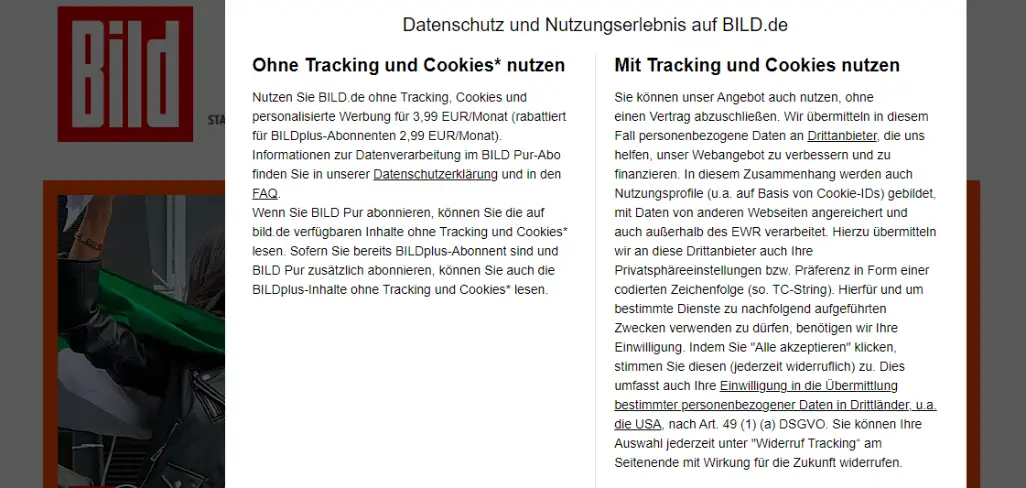
In the EU, consumers and businesses alike are far more conscious of data safety, and even this can be monetized via a paywall model. Germany’s Bild, for instance, will allow you to navigate the site for free if you accept tracking and cookies, but requires you to subscribe if you want to proceed without giving up your data.
All of these examples are primarily news-based, but you can look at different services for other examples. All of the streaming sites you’re used to such as Sky, DAZN, or Netflix tend to use hard paywalls since you can’t watch their programming unless you pay. Apps like Tinder use soft paywalls since you can use the app for free but gain significant advantages and extra features if you pay a premium.
How to Set Up a Paywall with Whop
Setting up a paywall is easy if you bring your business to an entrepreneur-focused platform like Whop—and what’s more, you can do so in just a few clicks! All you need to do is visit Whop.com to get started.
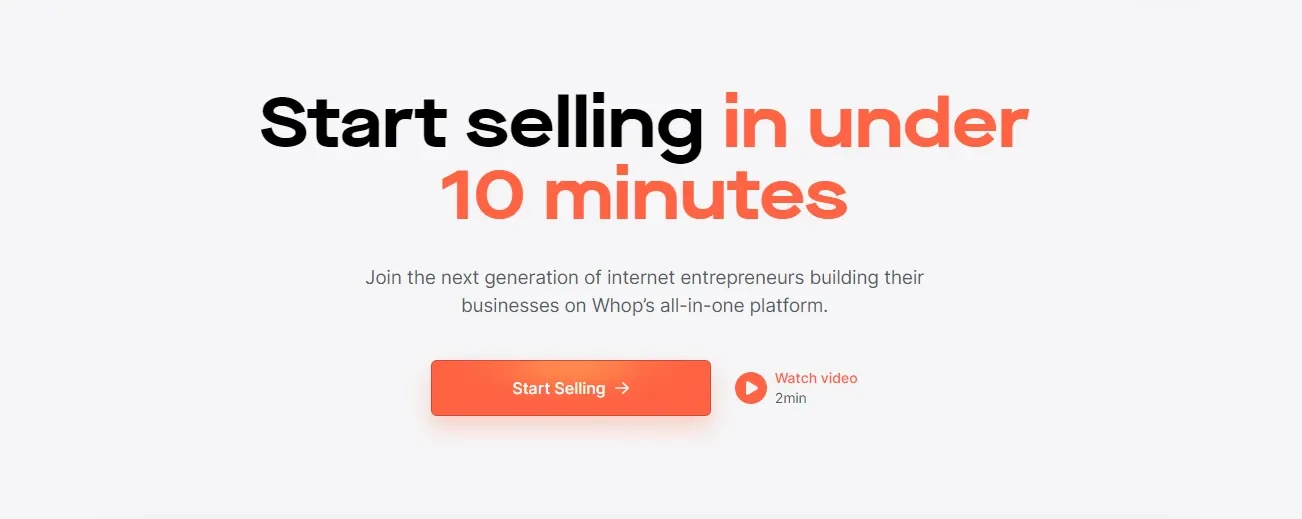
You’ll be prompted to create an account, which you can do quickly via an existing Discord, Twitter/X, Google, or Apple account. Alternatively, type in whatever email address you already have for your business.

Your Whop store is what customers will visit to complete their payment to your paywall. You can also integrate Whop with your site, but what’s important here is that your Whop store name corresponds to whatever brand you use for your business.
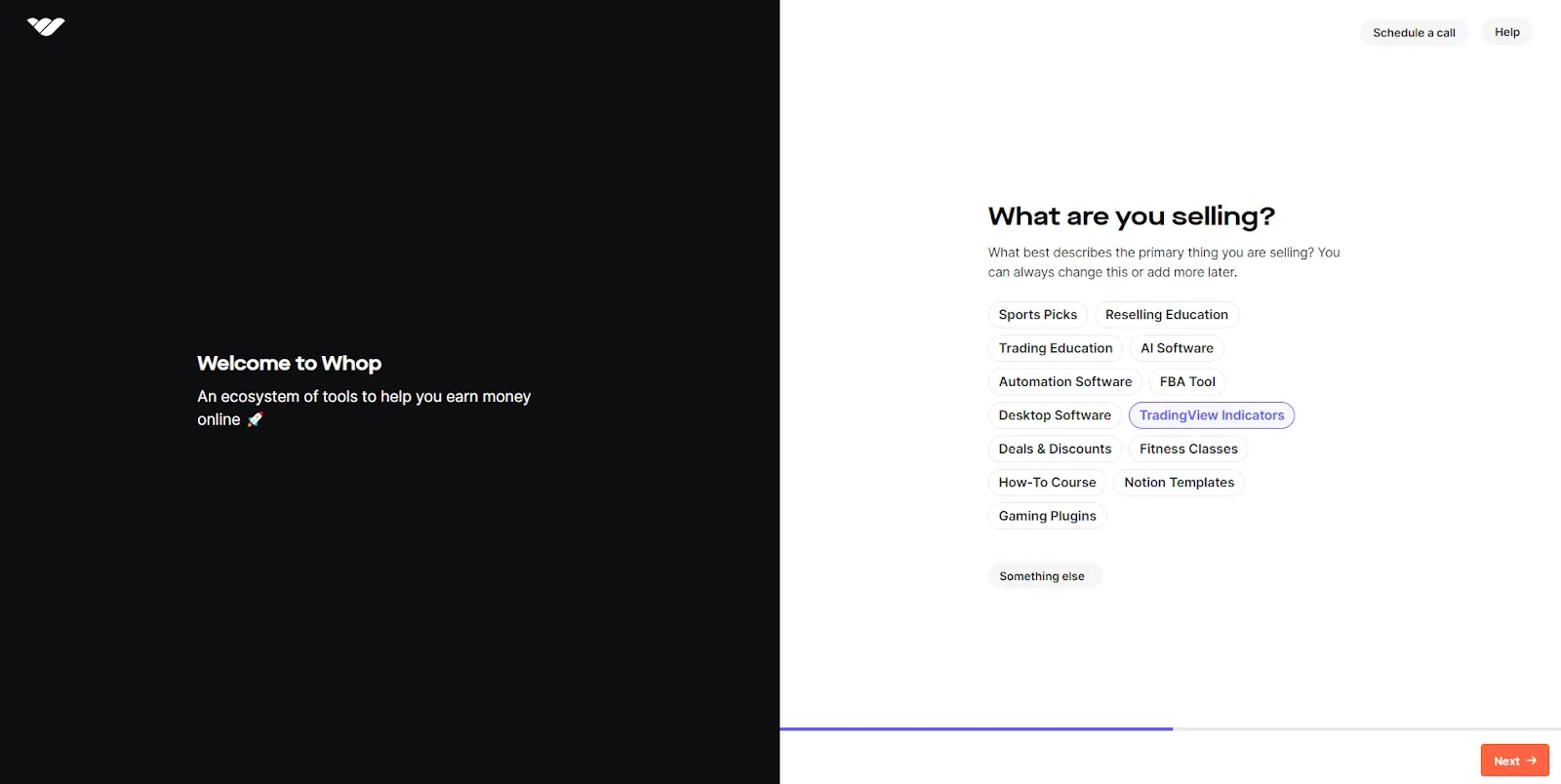
Once you’ve selected the general nature of your product or service, you’ll be led to your Whop Business Dashboard. Feel free to get comfortable with it, and don’t forget to check the Billing section for payment options. The Product section, however, is what we’re most interested in right now.
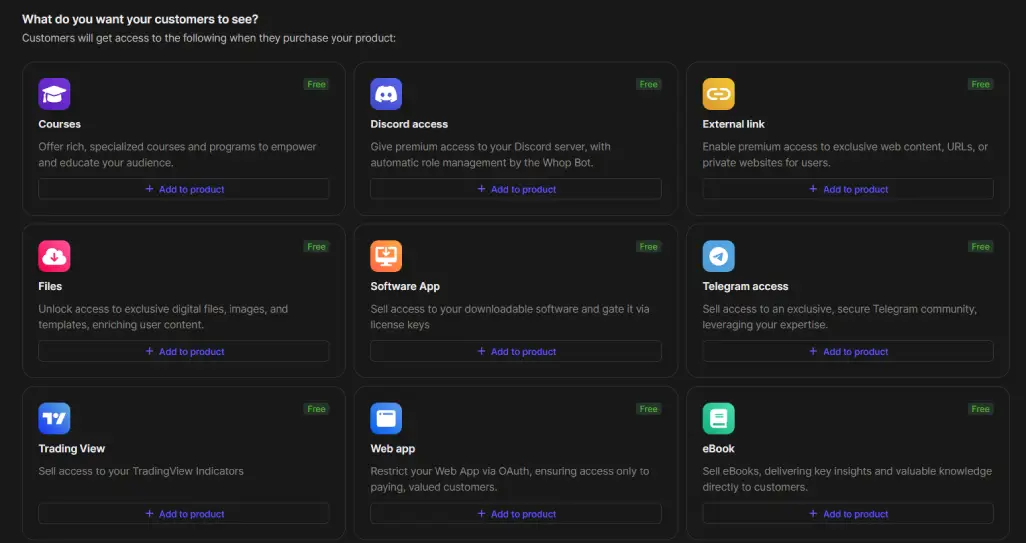
Here’s where the magic happens. If you’re a content creator, you might want to give paying subscribers access to your Discord or Telegram. You can also paywall your site using the Web App functionality, or particular URLs using the External Link option.
If you need more assistance setting up your store page or getting your paywall just right, just schedule a call with one of the Whop team via your business dashboard.
Should You Use a Paywall?
Whether or not to implement a paywall for your business is not a decision to be taken lightly. Just like any major strategy revolving around monetization, it depends on a lot of factors, and certain types of paywalls may be more or less suitable for your business depending on what stage of growth you’re in and how powerful your brand is.
When to Use a Hard Paywall
The most black-and-white of the paywall options is the hard paywall. As we’ve already mentioned, consumers don’t like it and your advertisers probably won’t like it either. You’re only going to want to consider a hard paywall if you’re either a highly reputable brand name in your niche, or if you have some sort of unique product.
Television networks like Sky, for example, bid millions for the right to broadcast various sporting events because it gives them exclusivity. They can then lean on this exclusivity to implement a hard paywall, knowing that they’re the only legal option for consumers who want to watch those events from the comfort of their own homes.
When to Use a Soft Paywall
A soft paywall is a lot more manageable for businesses of all sizes, and it allows you to continue growing your brand without throttling your growth, especially if you’re in the content creation business or an app developer.
Free access ensures that you’ll have the maximum number of users or visitors, and as long as you maintain a certain level of quality, plenty of these will consider switching to your paid subscriptions or buying premium options. Most content creators use this option, putting free content out there to build an audience and running a subscriber community on platforms like Whop with extra content and exclusive benefits
➡️To read more about setting up a subscription for your Discord server, click here
When to Use a Metered Paywall
A metered paywall could be a good option for your business if you want to offer your customers a lot of free value but also gain revenue from those who extract the most value from your product or service. That’s why this model is often seen in SaaS—you can offer a limited number of things like reports for free but then charge for an unlimited amount since, if the client needs that quantity, it clearly has value to them.
➡️To read more about SaaS subscriptions, click here
When to Use a Dynamic Paywall
A dynamic paywall can require a certain amount of sophistication to implement since you’ll need to collect and analyze the right data and set up algorithms to execute the strategy correctly. That said, it can definitely pay dividends in terms of giving you the ability to target different groups of customers in different ways—this can really optimize your acquisition process.
When to Use Donations
Donations can be an excellent option but have a low probability of bringing in significant revenue. Relying on them as a primary source of revenue can be a very risky idea, since they rely not only on your delivering a significant quantity and frequency of high-value products, but also on the likelihood of your target customer donating.
The Guardian is an excellent example of this, since not only is the paper’s reporting of an objectively high standard, but it’s also not unreasonable to imagine that the average Guardian reader is willing to donate money.
If your target customer fits a similar profile, you might certainly consider donations since not only will your customer appreciate high quality content for free and be likely to donate, but your advertisers (likely your primary revenue source) will pay you a premium since your customers are also more valuable to them.
Use Whop to Manage Your Paywall!
Whether or not to set up a paywall can be a difficult decision, but you can make it easy for yourself by identifying your goals and the immediate aims of your business. If you’re a growing content creator, a strategy like a hard paywall might be shooting yourself in the foot, but donations might see your top line stagnate if you don’t already have the advertising money flowing in. As such, deciding on whether to implement a paywall and then picking which one is something that’s best done carefully and with a partner like Whop.
👉 When you sign up to Whop, whatever your business, we can help set up the right paywall for you. Even better, you have all of the analytics on hand so you can track how your new paywall is transforming your business, retaining the ability to make effective, agile decisions. Visit Whop.com to sign up or talk to the team today!





